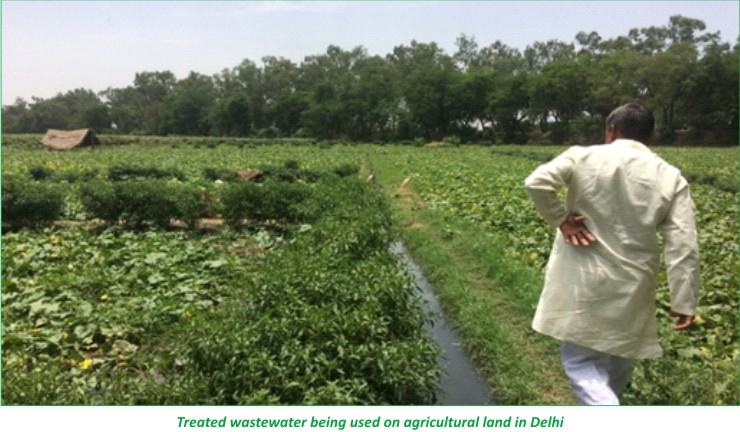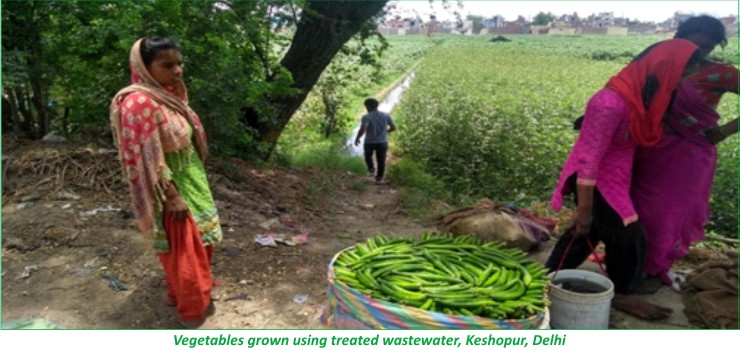Use of Treated Wastewater in Irrigation
Wastewater
use has become a good choice for preserving and increasing accessible water
supplies due to the scarcity of fresh water. Wastewater use can have many
types of applications, such as irrigation of agricultural land, aquaculture,
landscape irrigation, urban and industrial uses, recreational and
environmental uses and artificial groundwater recharge1.
Principally, wastewater can be used for all functions that freshwater is
employed for, after appropriate treatment. With a few exceptions worldwide,
wastewater use applications are restricted to non-potable uses, or at most
to indirect potable uses.2
Wastewater use in agriculture is by far the most established application, and the one with the longest tradition. In most cases the irrigated lands are located in or near the urban areas where the wastewater is generated. Estimates on wastewater use worldwide indicate that about 20 million hectares or agricultural land is irrigated with (treated and untreated) wastewater3. The unreported use of wastewater in agriculture can be expected to be significantly higher. It is particularly common in urban and peri-urban areas of the developing world.

Benefits and Risks of Using Treated Wastewater in Irrigation
Wastewater use in agriculture has certain benefits, providing water and nutrients for the cultivation of crops, ensuring food supply to cities, ensuring water supply during drought and reducing the pressure on available fresh water resources. However, wastewater is also a source of pollution, and can affect the health of farmers, consumers and the environment if safe practices are not applied. While population and urban areas are growing at exceptional rates and water scarcity is increasing, it is expected that, in the near future, the use of wastewater in agriculture will increase further in areas where fresh water is scarce.4
Waste Water Use in Irrigation in Delhi
Out of 3800 MLD (million litres per day) wastewater generated, only 1500 MLD is treated and about 205 MLD water is utilised for irrigating 937.92 ha of land whereas some of the treated water is given to DDA (Delhi Development Authority), CPWD (Central Public Works Department), DTC (Delhi Transport Corporation) for horticulture and other purposes. The water from Keshopur and Coronation STP (Sewage Treatment Plant) is carried through open channels to the pump house from where the water is pumped into DIFC (Department of Irrigation and Flood Control) minor and major channel through 600 mm pipe whereas the water from Okhla STP is directly dumped in DIFC channel.
In developing countries like India, the problems associated with wastewater reuse arise from its lack of treatment. The challenge is to find low-cost, low O&M technologies which help to avoid microbial, environmental and chemical risk. Other measures can be taken to minimise risks associated with wastewater use such as appropriate combination of wood trees, fruit trees, fodder, industrial crops and cereals. Farmers should be encouraged to adopt modern methods of irrigation like drip. Efficient strains of microbes for waste water remediation should be searched out and applied at field scale. Farmers should be made aware to use fresh water for washing the produce before taking to the market. Consumers should also resort to sufficient washing and cooking to reduce pathogen load. Regular health checks and administration of contaminants and awareness campaign should be carried to educate the farmers, consumers and policy makers about wastewater issues and impacts.5

Way Forward
In the current scenario, it will be good to address the issues by understanding the wastewater management practices of other nations too. For example, Israel recycles 90% of its wastewater and currently exports water to other nations too. The Water Authority under the Water Law of Israel involves the Ministry of Health and Ministry for Environmental Protection for controlling potable water quality and water pollution prevention respectively. The law also calls for reduced freshwater allocations to agriculture and reuse of treated wastewater. Thus, a combination of economic tools, technologies and strict environmental regulations could be a way forward for Delhi to improve the wastewater reuse.
Endnotes
1. Qadir, M., Wichelns, D., Raschid-Sally, L., McCornick, P. G., Drechsel,
P., Bahri, A., & Minhas, P. S. (2010). The challenges of wastewater
irrigation in developing countries. Agricultural Water Management, 97(4),
561-568.
2. Hanjra M A, Drechsel P, Wichelns D and Qadir M 2015
3. Transforming urban wastewater into an economic asset: opportunities and
challenges Wastewater: Economic Asset in an Urbanizing World (Dordrecht:
Springer) pp 271–8 (https://doi.org/10.1007/978-94-017-9545-6_14)
4. Jimenez, B., & Asano, T. (2008). Water reclamation and reuse around the
world. Water Reuse: an international survey of current practice, issues and
needs, 14, 3-26.
5. Proceedings of the UN-Water project on the Safe Use of Wastewater in
Agriculture, August 2013 © UNW-DPC, 2013.
■
Yugal Sandilya & Neha Agarwal
yugalsandilya@gmail.com, nagarwal@devalt.org